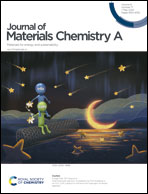Phosphate ion and oxygen defect-modulated nickel cobaltite nanowires: a bifunctional cathode for flexible hybrid supercapacitors and microbial fuel cells†
Abstract
The exploration of efficient and cost-effective cathodes for flexible hybrid supercapacitors (HSCs) and microbial fuel cells (MFCs) is highly desirable but challenging. Benefiting from the strong points of abundant sources, low price and respectable theoretical capacity, nickel cobaltite (NCO) has a wide applicable prospect as a cathode for flexible HSCs and MFCs. Nevertheless, the capacity, rate capability and oxygen reduction reaction (ORR) activity of the NCO are far from ideal due to its intrinsic weak conductivity. Herein, a feasible and valid method is employed to modify NCO nanowires (NWs) as a high performance cathode for flexible HSCs and MFCs via introducing phosphate ions and oxygen defects. Due to the larger surface, more active sites and faster charge transfer, the assembled flexible HSC device delivers a high energy density of 211 W h kg−1, and the MFC device achieves a power density of 3276.1 mW cm−2. This work may shed light on the modulation of phosphate ions and oxygen defects in enhancing the electrochemical performance of metal oxide electrodes, holding great potential for future flexible multifunctional electrodes.



 Please wait while we load your content...
Please wait while we load your content...